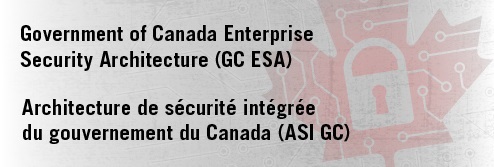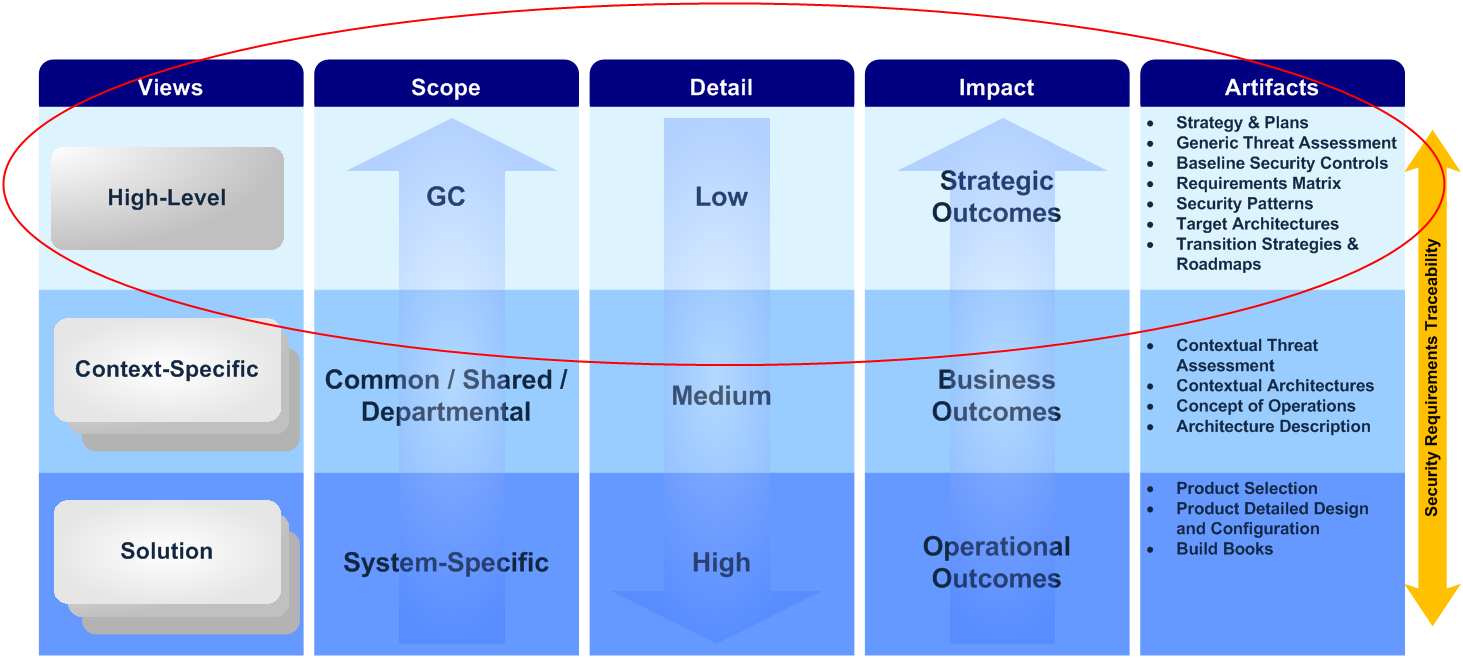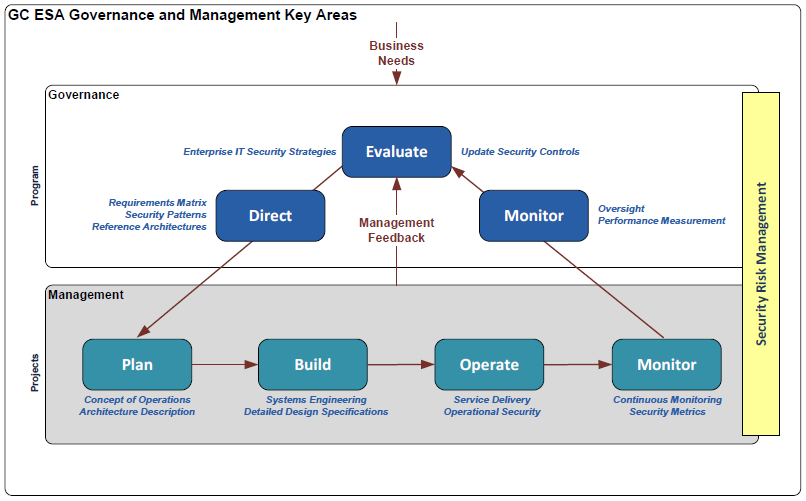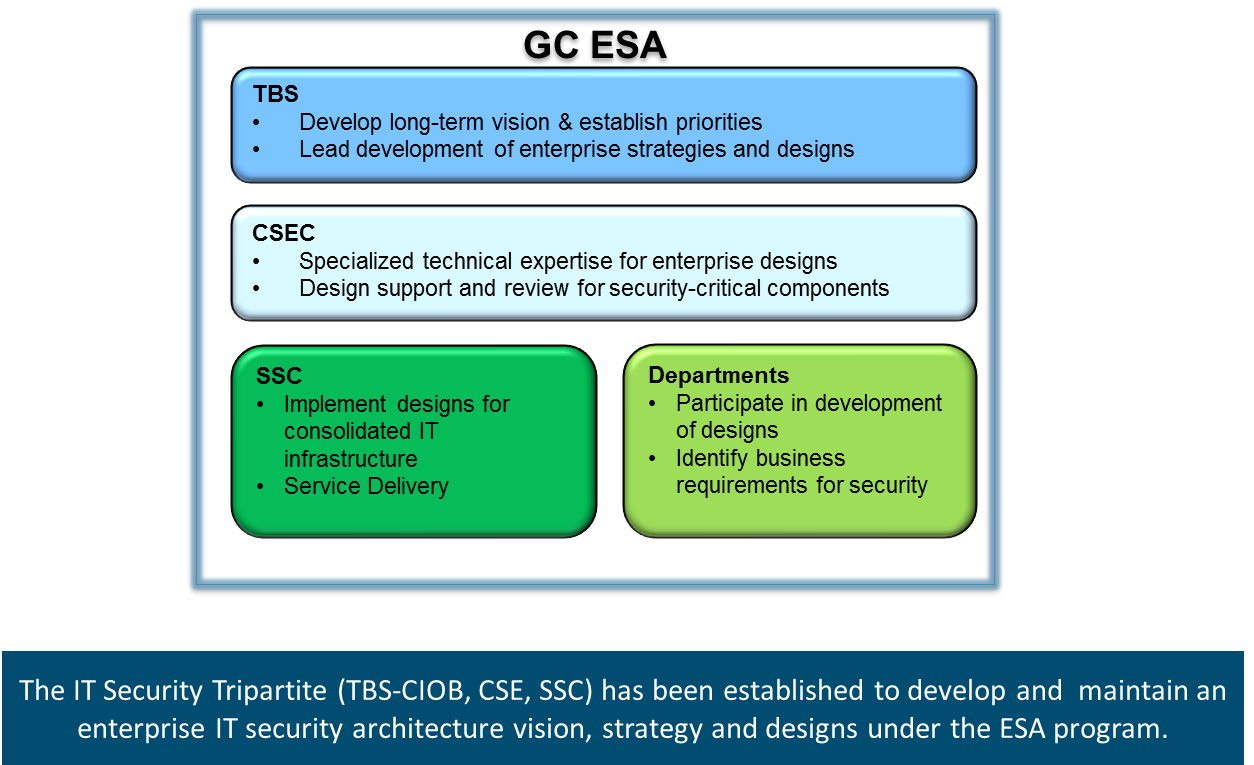ESA Program Charter
Overview of the GC ESA Program Charter
The GC ESA Program Charter describes the ESA initiative and provides a framework to support the delivery of the program and its objectives. The program charter will guide the execution and control of the GC ESA program. It also documents the program's definition and characteristics, as well as provides an overview of the program governance, roles and responsibilities, and high level plans. Its key points are summarized on this page, but for more detail, please read the GC ESA Program Charter.
Context for the Program Charter
The program charter identifies two documents that provide context for and support the development of the GC ESA Program.
Canada's Cyber Security Strategy
Canada's Cyber Security Strategy (CCSS), which was published in 2018, demonstrates the GC's commitment to protecting Canada's cyberspace. CCSS is national in scope and comprises of three fundamental pillars:
- Securing Government Systems
- Partnering to Secure Vital Cyber Systems Outside the Federal Government
- Helping Canada to be Secure Online
CCSS has identified several areas that need to be addressed in terms of securing government systems, including keeping pace with evolving cyber threats, enhancing the security of the GC cyber architecture, addressing global supply chain issues, and improving cyber security education and awareness. The ESA program is focused on dealing with these Pillar 1 activities.
For more information, please read Canada's Cyber Security Strategy.
Strengthening the Security of Federal Cyber Systems: A Backgrounder
As outlined in the Strengthening the Security of Federal Cyber Systems: A Backgrounder (aka the "GC ESA Backgrounder"), enhancing the security posture of GC systems and networks requires a comprehensive IT security strategy that includes developing IT security architecture designs, implementing defence-in-depth IT security capabilities based on these designs, and detecting and effectively responding to cyber threats. It also means ensuring that GC users understand and adhere to applicable security policies and know-how to identify and respond to cyber threats directed at end users. Finally, enhancing the security posture of GC systems requires that the GC understand how the IT landscape is evolving and that it continues to align its IT security strategy with its overall IT strategy.
The Backgrounder describes three fundamental themes:
- Improve our understanding of the cyber threat landscape
- Strengthen defensive capabilities
- Establish incident recover capabilities
GC ESA Program Scope, Approach, and Deliverables
The GC ESA Program Charter states that overall objective of the ESA program is to ensure that security is built into the designs of the IT infrastructure as it undergoes its transformation. The GC must, on an ongoing basis, identify threats to GC networks and systems, prioritize and counter identified and potential threats, and continually improve the robustness and security of the GC IT infrastructure.
Scope
As the image on the left shows, the program charter establishes that the scope of the ESA program is high-level, with a focus on enterprise as a whole, but it can also assist with security activities at all layers.
The GC may develop IT security architectures that can be categorized into three groups based on level of detail:
High-level view: Artifacts developed at this layer are high-level with GC Enterprise in scope and have a strategic impact. Examples include an Enterprise Security Concept of Operations or a GC Baseline Threat Assessment.
Context-specific view: Artifacts developed at this layer provide supplementary details, are common, shared or departmental in scope and have a tactical impact. Examples include a specific focus area Security Requirements Traceability Matrix, or a context-specific architecture (e.g. Business Control Profile for a Human Resources System).
Solution view: Artifacts developed at this layer are very detailed, system-specific in scope and have an operational impact. Examples include detailed design documentation or a Standard Operating Procedure for a Data Loss Prevention System.
For more information about the scope of the GC ESA program, please read the GC ESA Program Charter.
Program Approach
The program charter also provides an overview of the governance, risk, architecture compliance, and monitoring and measurement strategies for the GC ESA program. It notes that the desired results of the GC ESA program can only be achieved through the collaboration of departments and agencies that have a specific role in designing and implementing the GC enterprise IT security architecture, with support from other lead security agencies and key stakeholders.
Governance and Management
The program charter dictates that a clear governance model and management model must be developed. The governance model should set the direction and objectives for the ESA program within the GC, and the management plan should execute the achievement of the objectives. The key areas for the GC ESA Program Governance model are:
- Evaluate
- Direct
- Monitor
The key areas for the ESA Program Management model are:
- Plan
- Build
- Operate
- Monitor
For more information about the governance and management of the GC ESA Program, please read the GC ESA Program Charter.
Risk Management
As outlined in the GC ESA Program Charter, to manage any risks, the ESA program will leverage terminology and concepts from CSE’s ITSG-33 - IT Security Risk Management: A Lifecycle Approach. The IT security risk management process documented in ITSG-33 defines a set of activities to ensure key steps are performed on an ongoing basis during the lifetime of the information systems, and to ensure risk management is applied from an enterprise perspective. Continuous improvement is a key aspect of the recommended process to ensure that as the threat environment evolves, so do the controls that have been put into place. For more information about how the ESA program will use a risk-managed approach, please read the GC ESA Program Charter.
Architecture Compliance
The program charter dictates that an architecture compliance review process is required to ensure that a consistent security posture of the IT architecture is maintained, security controls are appropriately implemented, and the total cost of ownership to the GC is minimized. An architecture compliance review is a scrutiny of the compliance of a specific project against established GC objectives and architectural criteria, such as the ESA program target architectures and security patterns. As a separate initiative led by TBS, a GC IT Architecture Review Board (GC ITARB) is being proposed that will include an architecture compliance review process. ESA program processes will be aligned with the GC ITARB as it is further developed.
Monitoring and Measurement
GC ESA target architectures and security patterns will help translate abstract policy and business requirements into more tangible security controls within an information system and provide a mechanism for security measurement. Security measurement can enable the GC to quantify improvements in securing information systems and demonstrate quantifiable progress in accomplishing GC strategic goals and objectives. A strategy will be developed to ensure that controls are monitored on an ongoing basis, remain effective, and are updated as required. At the ESA program level, monitoring of performance using metrics enables management to ensure that goals are achieved, in accordance with the goals and objectives outlined in the GC ESA Program Charter.
Stakeholders and Governance Structure of the ESA Program
Key Stakeholders
As explained in the ESA Program Charter, the desired results for the enterprise IT security architecture can only be achieved through the collaboration of departments and agencies that each have specific roles in designing and implementing it. While the ESA program encompasses the entire GC, there are three key stakeholders that play a large role in designing and implementing the program, as part of the GC enterprise IT security architecture. The image on the left shows the three key stakeholders, the Treasury Board of Canada Secretariat, Shared Services Canada, and Communications Security Establishment, and it briefly describes the role each of them play in carrying out the GC ESA program:
Treasury Board Secretariat: Develops the long-term vision and establishes the priorities for the ESA program. It also leads the development of enterprise strategies and designs.
Shared Services Canada: Implements designs for consolidated IT infrastructure and provides service delivery.
Communications Security Establishment: Provides specialized technical expertise for enterprise designs and contributes design support and review for critical components.
These three stakeholders formed the IT Security Tripartite to develop and maintain a consistent and cohesive enterprise IT security architecture vision, strategy and designs under the ESA program.
Also included in the image on the left are the many other departments that are participating in the development of designs for the IT security architectures and identifying business requirements for IT security.
Relationship of the ESA Program Governance to GC IT Security Governance
The image below shows the relationship of the IT Security Tripartite with the current GC Security Governance Structure. The IT Security Tripartite consists of members from the ADM Security and Identity Committee (ADM SIDC). Communication is required to both the GC Security Forum, as well as to the Chief Information Officer Council (CIOC), which is the GC CIO's advisory body.
For more information about the ESA program key stakeholders and the relationship of the ESA program governance to the GC security governance, please read the GC ESA Program Charter.






